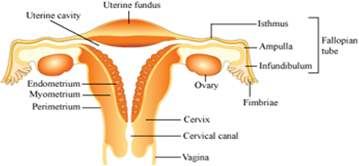 Short Answer Type
Short Answer TypeWrite the function of each one of the following:
(a) (Oviducal) Fimbriae
(b) Coleoptile
(c) Oxytocin Long Answer Type
Long Answer TypeThe following is the illustration of the sequence of ovarian events (a to i) in a human female.
i) Identify the figure that illustrates ovulation and mention the stage of oogenesis it represents.
(ii) Name the ovarian hormone and the pituitary hormone that have caused the above mentioned event.
(iii) Explain the changes that occur in the uterus simultaneously in anticipation.
(iv) Write the difference between c and h.
(v) Draw a labeled sketch of the structure of a human ovum prior to fertilization.
How does the megaspore mother cell develop into 7-celled, 8 nucleate embryo sac in an angiosperm? Draw a labeled diagram of a mature embryo sac.
(a) Draw a labelled diagram of the human female reproductive system.
(b) Enumerate the events in the ovary of a human female during:
(i) Follicular phase
(ii) Luteal phase of menstrual cycle
(a) 
(b)
(i) Follicular phase: Follicular phase is also called the proliferative phase. During this phase the FSH released by the pituitary stimulates the growth of the primary ovarian follicle and also causes maturation of the primary oocyte in this follicle. The follicular cells of the Graafian follicle secrete oestrogen. Due to an increase level of estrogen the uterine endometrium becomes thick, more vascular and more glandular. This phase lasts for about 10 to 14 days, or until ovulation occurs. The luteinizing hormone (LH) released by the pituitary induces the mature Graafian follicle to burst and release the egg or ovum into the fallopian tube. This is called ovulation.
(ii) Luteal phase: The luteal phase is also called secretory phase or the post -ovulatory phase. It follows the ovulation. During this phase the corpus luteum continues to release the hormone, progesterone. It lasts for about 12 - 14 days and extends from the 16th - 28th day of the menstrual cycle.
(a) Write the specific location and the functions of the following cells in human males:
(i) Leydig cells
(ii) Sertoli cells
(iii) Primary spermatocyte
(b) Explain the role of any two accessory glands in human male reproductive system.
 Short Answer Type
Short Answer TypeWhy are the human testes located outside the abdominal cavity? Name the pouch in which they are present.
 Long Answer Type
Long Answer Type(a) Where does fertilization occur in human ? Explain the events that occur during this process.
(b) A couple where both husband and wife are producing functional gametes, but the wife is still unable to conceive, is seeking medical aid. Describe any one method that you can suggest to this couple to become happy parents. Short Answer Type
Short Answer TypeHow is the entry of only one sperm and not many ensured into an ovum during fertilisation in humans?
